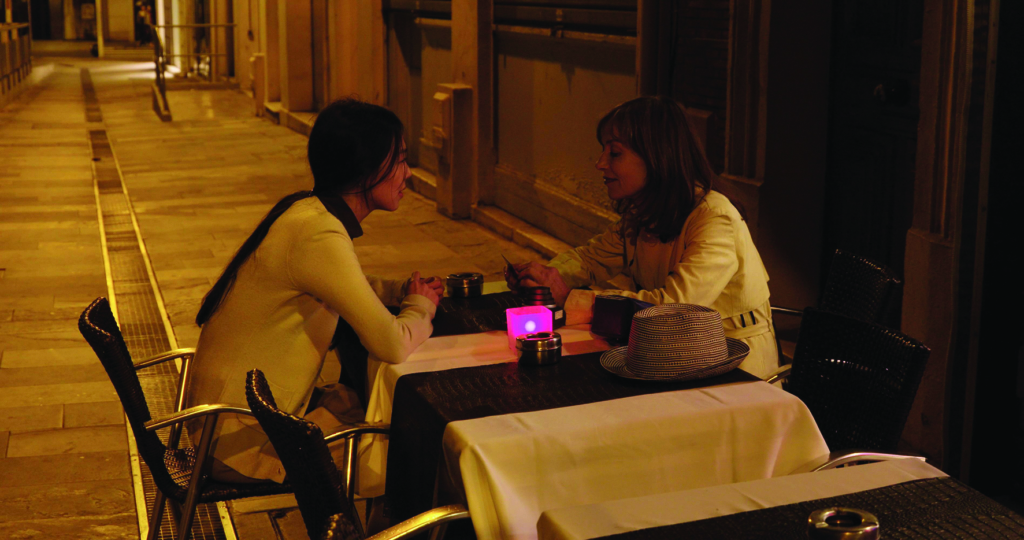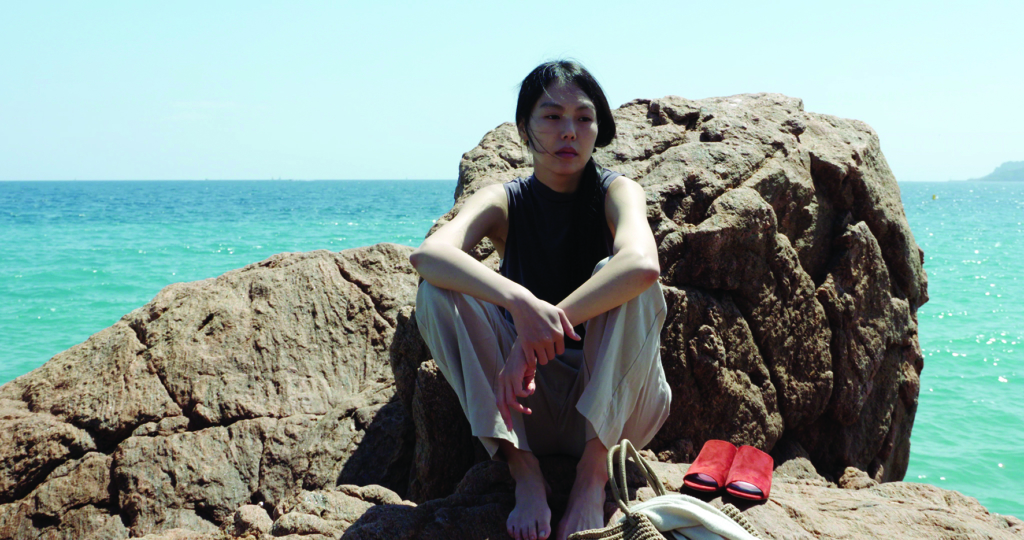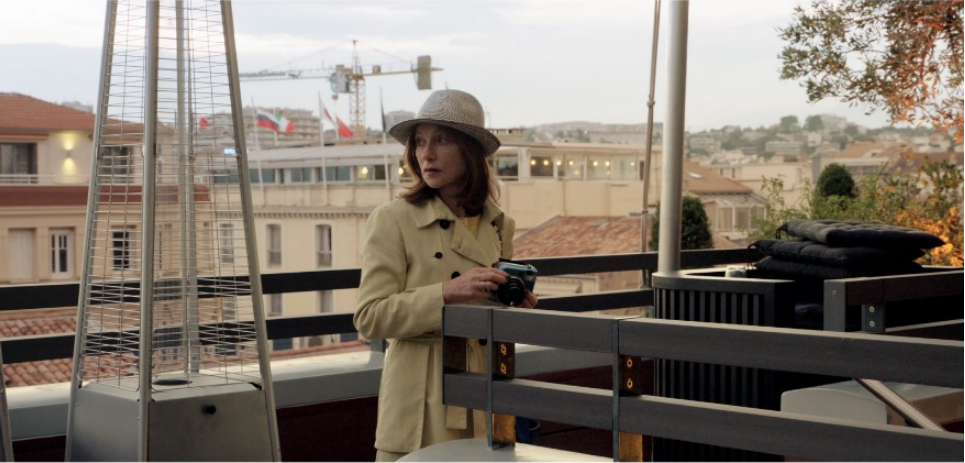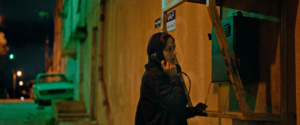The choice to have Claire’s Camera (Hong Sang-soo, 2017) open the 2017 Queensland Film Festival seemed entirely appropriate. Opening-night films tend to be light-hearted affairs, screened to accompany hors d’oeuvres and sparkling wine. Running at just under seventy minutes, Hong’s Rohmeresque film of romantic and professional complications intertwining on the outskirts of the Cannes Film Festival fitted the bill perfectly.
The critical response that followed Claire’s Camera’s out-of-competition premiere at (the real-life) Cannes certainly suggests that it’s an easygoing film. Variety described it as a ‘lovable wisp of a character study’;[1]Guy Lodge, ‘Film Review: Claire’s Camera’, Variety, 22 May 2017, <http://variety.com/2017/film/reviews/claires-camera-review-isabelle-huppert-1202439554/>, accessed 4 March 2018. The Film Stage framed it as ‘a decidedly laid-back affair’.[2]Giovanni Marchini Camia, ‘Claire’s Camera: Cannes 2017 Review’, The Film Stage, 27 May 2017, <https://thefilmstage.com/reviews/claires-camera-review-hong-sang-soo-isabelle-huppert-cannes/>, accessed 4 March 2018. The Hollywood Reporter, [3]Deborah Young, ‘Claire’s Camera (Keul-le-eo-ui ka-me-la): Film Review | Cannes 2017’, The Hollywood Reporter, 21 May 2017, <https://www.hollywoodreporter.com/review/claire-s-camera-review-1005953>, accessed 4 March 2018. Slant[4]Sam C Mac, ‘Cannes Film Festival 2017: Hong Sang-soo’s The Day After and Claire’s Camera’, Slant, 25 May 2017, <https://www.slantmagazine.com/house/article/cannes-film-review-the-day-after-and-claires-camera>, accessed 4 March 2018. and Film Comment[5]Jordan Cronk, ‘Interview: Hong Sangsoo’, Film Comment, 1 July 2017, <https://www.filmcomment.com/blog/interview-hong-sangsoo/>, accessed 4 March 2018. all chose ‘breezy’ as the adjective du jour (though it’s worth noting that the last of these qualified the descriptor with ‘deceptively’). I don’t mean to quibble with these critics’ characterisation of the film: Claire’s Camera is delightfully refreshing and refreshingly delightful, particularly for viewers neck-deep in the grim social dramas that tend to dominate contemporary film fests. If you want to evoke the experience of idly wandering the sunny streets of Southern France after perhaps a beer (or soju) too many, you could do much worse.
Nonetheless, I’d argue that the film’s lightness belies a deeper, more sophisticated examination of relationships and how we perceive them. In their aforementioned reviews, both Variety and The Hollywood Reporter read the film as an ode to the medium – as being about, respectively, ‘the restorative powers of cinema’[6]Lodge, op. cit. and ‘[t]he eternal question of whether cinema […] can make a difference in people’s lives’.[7]Young, op. cit. I don’t see much evidence to support either interpretation, but I’ll concede that Claire’s Camera is primarily about how we see and how we remember – actions ingrained in the soul of cinema.

Hong’s camera
To understand Claire’s Camera, we need to understand its creator. This is Hong’s twentieth feature, his first being The Day a Pig Fell into the Well (1996). It’s also one of three films by the Korean director released in 2017, alongside On the Beach at Night Alone and The Day After. Hong is the very definition of an auteur: he has written (almost[8]With the exception of The Day a Pig Fell into the Well. ) all of his films, and they are so similar that they blend into one another once you’ve seen more than a few. His style is simple, unostentatious: long takes, one camera, obtrusive zooms. He shoots in chronological order, writing during production and allowing for plenty of improvisation. His filmography is filled with older men trying to sleep with younger women, invariably over dinners fuelled by a staggering amount of soju.[9]Of course, as with any great auteur, he welcomes opportunities for experimentation: some of his films feature beer and/or wine.
Profiling the director for Metro three years ago, Anthony Carew posited that ‘isolating specific films isn’t the way to approach Hong’s canon, which is best taken as a collective’;[10]Anthony Carew, ‘Expectedly Unexpected: Repetition and Understatement in the Films of Hong Sang-soo’, Metro, no. 186, Spring 2015, p. 85. I’d argue that Claire’s Camera is likewise best understood in the context of Hong’s other films of 2017 and the director’s private life. Many critics have contextualised On the Beach at Night Alone, The Day After and (to a lesser extent) Claire’s Camera around Hong’s affair with actress Kim Min-hee, who stars in all three. This isn’t an empty attempt at invoking extratextual scandal for clicks, either; all of Hong’s 2017 films address the ramifications of infidelity between an older artist and a younger woman.
This isn’t unfamiliar subject matter to Hong. Carew finished his profile by observing, ‘Wondering which Hong film features a filmmaker pressuring a younger woman to have sex with him is a little like trying to remember which Ramones song starts out, “One, two, three, four!”’[11]ibid., p. 87. What distinguishes these three films and the director’s prior works is twofold: the emphasis in the 2017 works is on the fallout of an affair, and the presence of Kim in each film overtly underlines the autobiographical context.
Claire’s Camera is about how we attempt to replay and reframe significant or traumatic events … it acts as a self-reflexive commentary on the kind of autobiographical reflection and refraction Hong is undertaking with his 2017 films.
But, in comparison to Hong’s other 2017 films, Claire’s Camera perhaps isn’t best described using the word ‘overt’. On the Beach at Night Alone – which earned Kim the Silver Bear for Best Actress at Berlinale, and is covered in more detail elsewhere in this issue[12]See David Heslin’s ‘States of Loneliness: Proximity and Distance in On the Beach at Night Alone’ in this issue of Metro, pp. 52–7. – centres on Kim’s character’s regret and rage at the after-effects of an affair with a film director. The Day After is more interested in the structures that facilitate such affairs: depicting a publisher who uses his social position to sleep with younger women, Hong casts Kim as a new hire whose nascent career is sabotaged by her egocentric boss. If we read these as self-reflexive, pseudo-autobiographical texts (and it’s hard not to), they strongly suggest Hong has some deep reservations about his affair with Kim.
Claire’s Camera, however, keeps its investigation of infidelity largely implicit. The film begins with the firing of Kim’s character, Man-hee, by her boss Nam (Chang Mi-hee). The conversation is intensely awkward: Nam offers up opaque platitudes about Man-hee being ‘good-hearted’ but ‘dishonest’ as justification for her dismissal. It isn’t until about halfway through the piece – after being introduced to film director So (Jung Jin-young), who both Nam and Man-hee were working for – that the real reason becomes clear.
Over a drunken lunch, we learn that So was sleeping with both Nam and Man-hee – so Nam’s oblique references to dishonesty were primarily motivated by jealousy.
But, unlike On the Beach at Night Alone and The Day After, there’s no particular interrogation of the ramifications of this affair on Man-hee; after she’s fired, she stays on in Cannes until her flight, enjoying the sights and befriending a mysterious woman named Claire (Isabelle Huppert), who also crosses paths with So and Nam. As such, it’s not especially surprising that critics have tended to elide the extratextual baggage when discussing Claire’s Camera.
I’d argue that’s a mistake. While Claire’s Camera doesn’t grapple with the psychological repercussions of infidelity with the same depth as On the Beach at Night Alone, nor its professional reverberations as insightfully as The Day After, what it does focus on – how our perceptions and memories are shaped by such life-changing events – is explored with as much sophistication as those two films.

Developing film
When you compare Claire’s Camera to Hong’s recent works, it’s easy to see why the film has been shunted to the sidelines. The narrative experimentation in 2014’s Hill of Freedom (in which an ostensibly straightforward storyline has the order of its scenes shuffled, seemingly randomly) or 2015’s Right Now, Wrong Then (which recounts its story twice across its running time) isn’t apparent in Claire’s Camera. That’s been characterised as a weakness by some critics, who variously complained that the film ‘lacks […] inventiveness and narrative complexity’[13]Carlos F Heredero, ‘Claire’s Camera (Hong Sangsoo). Special Session’, in Heredero et al., ‘Festival de Cannes.’, Caiman cuadernos de cine, 18 May 2017, <https://www.caimanediciones.es/cannes-2017-en-tiempo-real-la-opinion-de-la-critica/>, accessed 4 March 2018, as translated by Google Translate. and ‘doesn’t offer a puzzle for the viewer to decrypt, a facet that drives some of his other films’.[14]Pierce Conran, ‘Review: Claire’s Camera, Hong Sangsoo’s Low-key Cannes Holiday’, Modern Korean Cinema, 26 August 2017, <http://www.modernkoreancinema.com/2017/08/review-claires-camera-hong-sangsoos-low.html>, accessed 4 March 2018. Similarly, at first glance, Claire’s Camera seems to lack the surrealistic, perhaps supernatural elements found across Hong’s filmography – think: the Buñuelian aspects of 2016’s Yourself and Yours (in which a woman’s identity seems to fluctuate from scene to scene, despite being played by the same actor) or of On the Beach at Night Alone (in which a mysterious man pops up throughout the film to either abduct the protagonist or lurk inexplicably outside a hotel room).
Pay attention to its particulars, however, and the seemingly linear narrative of Claire’s Camera unravels. For example, Claire enters the picture when she stumbles upon So at a Cannes cafe; they strike up a conversation, and he’s later surprised to find Claire has a picture of Man-hee that, she explains, she took ‘this morning, when I arrived. I was on the rooftop of a big hotel.’ In the very next scene, Claire encounters Man-hee and takes a photo of her; it’s as though they haven’t met before, but their conversation is ambiguous enough that their relationship (or lack thereof) is unclear.
The film progresses in an apparently linear fashion for a few scenes, using Claire as a kind of connective tissue between Man-hee and Nam/So as she bounces back and forth between them. But the last few scenes challenge this apparent linearity; at a party – on what appears to be a hotel rooftop! – So’s, Man-hee’s and Claire’s paths cross; So challenges Man-hee on her outfit (her jean shorts are too short, according to him) and, after he departs, Claire tries to take a photo of Man-hee, who tearfully tells her, ‘Don’t take pictures!’ Claire, ashamed, leaves without Man-hee, but the very next scene sees the two women walking the streets at night as friends.

The chronological sequencing of these scenes gets trickier if you pay attention to the outfits. The editing would suggest that Claire and Man-hee move from the rooftop to the streets, their brief conflict resolved. But, while Claire is wearing the same yellow outfit she’s seen in throughout the film, Man-hee isn’t clad in what she wore on the rooftop – in fact, she’s wearing the same outfit we see early on in the film, when she’s talking about her having been fired to a friend (who isn’t seen again in the film). Perhaps the rooftop encounter was a flashback? But we see a close-up of the photo of Man-hee shown to So and Nam, and Man-hee’s clothes don’t match what we saw her wearing on the rooftop, nor does this gel with Man-hee’s hostile reaction to Claire taking a photo.
I digress; I’m sure few readers are interested in the intricacies of the costuming and sequencing. What’s important is that Claire’s Camera doesn’t fit together as a conventional, linear narrative at all, and the order of events is obscured. There is a puzzle here, and it’s difficult to decrypt. A possible explanation is offered by the enigmatic Claire, who – significantly – wears the exact same outfit in every scene of the film, and may be more than she appears. This sounds ridiculous, I’ll admit, but I’m not the only critic to make these observations: Variety’s Guy Lodge wonders whether Claire’s camera might have special powers – in a ‘modest infusion of magical realism’[15]Lodge, op. cit. – while Sight & Sound’s Giovanni Marchini Camia muses that Claire ‘may or may not be fully real’.[16]Giovanni Marchini Camia, ‘Claire’s Camera and The Day After Review: Two Poles of the Hong Sangsoo Affair’, Sight & Sound, 26 May 2017, <http://www.bfi.org.uk/news-opinion/sight-sound-magazine/reviews-recommendations/claires-camera-day-after-review-hong-sangsoo-two-poles-affair>, accessed 4 March 2018.
This aura of ambiguity isn’t arbitrary. Claire’s Camera is about how we attempt to replay and reframe significant or traumatic events; placed in proximity to On the Beach at Night Alone and The Day After, it acts as a self-reflexive commentary on the kind of autobiographical reflection and refraction Hong is undertaking with his 2017 films.
The subtly fragmented nature of the narrative is brought into focus by the repetition of characters attempting to reframe and relive their pasts. These moments occur in conventional conversation, as when So breaks up with Nam, offering a sort of sombre debrief of their relationship, or when Claire reminisces about an ex-lover; and in conventional cinematic terms, as in the presumable flashback to Man-hee’s firing, triggered by a subsequent conversation with a friend about the event.

There are more radical examples. Late in the film, Man-hee returns with Claire to the spot where she was fired and restages the event in her mind, with Hong overlaying the scene with dialogue from that earlier conversation. This is treated as a coping mechanism of sorts: Man-hee coming to terms with the moment by going over it again. But the most significant scene along these lines requires a knowledge of Hong’s personal life. Mike D’Angelo describes the scene of So and Nam ending their relationship as ‘wish fulfillment […] especially given that Hong’s wife has reportedly been ducking process servers for months, determined not to grant him a divorce’.[17]Mike D’Angelo, ‘Claire’s Camera’, Letterboxd, 8 June 2017, <https://letterboxd.com/gemko/film/claires-camera/>, accessed 4 March 2018.
Wish fulfilment? Certainly. But so, too, is the dream sequence late in On the Beach at Night Alone, in which Kim’s character confronts her film-director ex-lover who ruined her reputation. That instance, with extratextual knowledge, could be seen as wish fulfilment for Kim, not Hong. And the authorship of that scene – directed and written by Hong but improvised by Kim – complicates matters further. Coming to grips with your past isn’t a simple process. It requires self-reflection and, invariably, that comes with a modicum of dishonesty (the same dishonesty Man-hee is chastised for in Claire’s Camera) as you reframe events to better suit your perception of yourself.
The key to understanding Claire’s Camera, then, is Claire’s camera. When Claire is talking about her photography, she says, ‘If I took a photo of you, you are not the same person anymore.’ That line is intended as more than a facile poetic device; in the context of this and Hong’s other films from 2017, it tells us that, by looking and remembering, we change ourselves. Hong staging an imaginary, amicable divorce conversation with a surrogate for his wife likely makes no difference to reality, but it allows him to come to terms with the rupture of that relationship – just as Man-hee’s restaging of her dismissal grants her some modicum of acceptance.
Of course, some things are easier to accept than others. Man-hee’s readiness to relive her firing is suggested within the scene itself, when she bizarrely requests to take a selfie with her ex-employer to ‘commemorate [her] firing’. Yet, when Claire stumbles upon Man-hee after a heated confrontation with So, Man-hee is upset by the prospect of a photograph. Given Hong’s readiness to tell pseudo-autobiographical stories from Kim’s perspective – but not his own – these moments are granted extra significance: suggestions that self-reflection is often difficult.

Self-reflection
In writing this piece, I’m imposing my own meaning upon the text. That’s what critics do. But it’s hard to miss the synchronicity of my actions – looking back on the film, cataloguing the outfits from scene to scene, reframing scenes in the context of evidence outside the film – with the processes undertaken by Hong and his characters.
There’s an argument – a persuasive one – to be made that Claire’s Camera is, in fact, that simple, ‘breezy’ film well suited for opening night. If we’re going to bring in extratextual evidence, Hong’s production process and interview comments support the supposition that Claire’s Camera is little more than a goof, cobbled together with Huppert and Kim over a few days at Cannes. Like Claire, in the process of looking, I’ve changed the nature of my subject.
Hong himself says that Claire’s Camera ‘is about as you see, as you are’.[18]Hong Sang-soo, quoted in Cronk, op. cit., emphasis added. Maybe the film isn’t intended as a meditation on the challenges of self-reflection, but there’s evidence to support that reading, intentional or otherwise. As Hong puts it: ‘All my films are autobiographical in [the] sense that whatever I do, they all end up showing something of myself’.[19]ibid. This piece may tell you something about Hong, and about Claire’s Camera, but it also tells you something about me; how could it not?
Endnotes
| 1 | Guy Lodge, ‘Film Review: Claire’s Camera’, Variety, 22 May 2017, <http://variety.com/2017/film/reviews/claires-camera-review-isabelle-huppert-1202439554/>, accessed 4 March 2018. |
|---|---|
| 2 | Giovanni Marchini Camia, ‘Claire’s Camera: Cannes 2017 Review’, The Film Stage, 27 May 2017, <https://thefilmstage.com/reviews/claires-camera-review-hong-sang-soo-isabelle-huppert-cannes/>, accessed 4 March 2018. |
| 3 | Deborah Young, ‘Claire’s Camera (Keul-le-eo-ui ka-me-la): Film Review | Cannes 2017’, The Hollywood Reporter, 21 May 2017, <https://www.hollywoodreporter.com/review/claire-s-camera-review-1005953>, accessed 4 March 2018. |
| 4 | Sam C Mac, ‘Cannes Film Festival 2017: Hong Sang-soo’s The Day After and Claire’s Camera’, Slant, 25 May 2017, <https://www.slantmagazine.com/house/article/cannes-film-review-the-day-after-and-claires-camera>, accessed 4 March 2018. |
| 5 | Jordan Cronk, ‘Interview: Hong Sangsoo’, Film Comment, 1 July 2017, <https://www.filmcomment.com/blog/interview-hong-sangsoo/>, accessed 4 March 2018. |
| 6 | Lodge, op. cit. |
| 7 | Young, op. cit. |
| 8 | With the exception of The Day a Pig Fell into the Well. |
| 9 | Of course, as with any great auteur, he welcomes opportunities for experimentation: some of his films feature beer and/or wine. |
| 10 | Anthony Carew, ‘Expectedly Unexpected: Repetition and Understatement in the Films of Hong Sang-soo’, Metro, no. 186, Spring 2015, p. 85. |
| 11 | ibid., p. 87. |
| 12 | See David Heslin’s ‘States of Loneliness: Proximity and Distance in On the Beach at Night Alone’ in this issue of Metro, pp. 52–7. |
| 13 | Carlos F Heredero, ‘Claire’s Camera (Hong Sangsoo). Special Session’, in Heredero et al., ‘Festival de Cannes.’, Caiman cuadernos de cine, 18 May 2017, <https://www.caimanediciones.es/cannes-2017-en-tiempo-real-la-opinion-de-la-critica/>, accessed 4 March 2018, as translated by Google Translate. |
| 14 | Pierce Conran, ‘Review: Claire’s Camera, Hong Sangsoo’s Low-key Cannes Holiday’, Modern Korean Cinema, 26 August 2017, <http://www.modernkoreancinema.com/2017/08/review-claires-camera-hong-sangsoos-low.html>, accessed 4 March 2018. |
| 15 | Lodge, op. cit. |
| 16 | Giovanni Marchini Camia, ‘Claire’s Camera and The Day After Review: Two Poles of the Hong Sangsoo Affair’, Sight & Sound, 26 May 2017, <http://www.bfi.org.uk/news-opinion/sight-sound-magazine/reviews-recommendations/claires-camera-day-after-review-hong-sangsoo-two-poles-affair>, accessed 4 March 2018. |
| 17 | Mike D’Angelo, ‘Claire’s Camera’, Letterboxd, 8 June 2017, <https://letterboxd.com/gemko/film/claires-camera/>, accessed 4 March 2018. |
| 18 | Hong Sang-soo, quoted in Cronk, op. cit., emphasis added. |
| 19 | ibid. |





